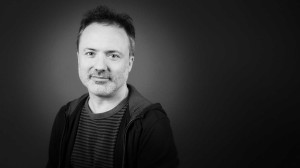
Alfonso Cuarón spent four and a half years making his latest film, Gravity, which since its October release has become both a critical darling and a stand out at the box office. Like Avatar before it, Gravity developed new ways of filmmaking while it waited for technology to catch up. But this is no sci-fi romp through the universe. The director’s vision for the film, co-written with his son Jonás, meant venturing into space as we know it — not as we might imagine it — with the trademark long, fluid shots and palpable environments he brought to his Oscar-nominated Children of Men.
“I knew it would require a certain amount of tricks, but it was not until we started trying conventional techniques that I realized in order to do the film the way I wanted to do it, we were going to have to create something entirely new,” said Cuarón.
Although additional effects shots were finished off-site, including the reentry sequence created by Australia’s Rising Sun Pictures and the stereo conversion by Prime Focus of live-action shots recorded traditionally on a uniquely configured stage, the vast majority of Gravity‘s visual effects effort was not set adrift in some distant, isolated orbit as so often VFX work is. Aided by his longtime cinematographer Emmanuel “Chivo” Lubezki and visual effects supervisor Tim Webber of London’s Framestore, Cuarón mapped out a stereo CG-centric plan, from meticulous pre-visualization, to virtual cameras and elaborate — and utterly unique — lighting systems on set.
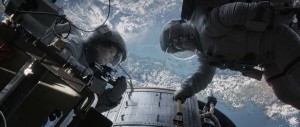
“Visual effects is normally just one department that does what it does,” said Webber. “On this film, it integrated with every other department. We all had to find our way through this new process together. The set dressers would come sit with the visual effects artists to dress the virtual sets. The artist would move props around on the screen and the set dresser would be saying, ‘let’s put some stuff up there.’ We learned so much from each other because we worked together in ways that just don’t normally happen on a film.”
The path to believable weightlessness in outer space, however, is littered with debris.
“Shooting in space is fairly straightforward,” said Webber. “But conveying zero gravity is just a very complicated challenge, as can be seen by the fact that very few movies ever take it head on. Doing that within a long shot adds yet another level of complexity. The long shots are challenging in their own right because you’ve got to design them so they work as one continuous shot. It becomes an even bigger challenge, however, when you combine it with zero gravity.”
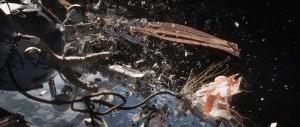 While advancements in rendering technology “have taken things to a level of reality and believability that wasn’t possible before,” Webber said it was not so much the render pipeline but the way the filmmakers both shot and got those images into the postproduction workflow that makes this film so unique. “The techniques we used for shooting the elements in a way that could be merged into the CG were where the groundbreaking workflows came in. We spent a full year doing the pre-vis and planning before we ever got to the stage.”
While advancements in rendering technology “have taken things to a level of reality and believability that wasn’t possible before,” Webber said it was not so much the render pipeline but the way the filmmakers both shot and got those images into the postproduction workflow that makes this film so unique. “The techniques we used for shooting the elements in a way that could be merged into the CG were where the groundbreaking workflows came in. We spent a full year doing the pre-vis and planning before we ever got to the stage.”
Inside the Light Box
A pivotal component of the Shepperton Studios set grew out of an idea Lubezki had after attending a Peter Gabriel concert with an extravagant light show.
“He saw the LED panels they were using and he wondered if we could use something similar on set as a way to light the actors,” said Webber, referring to the film’s stars Sandra Bullock and George Clooney. “It ended up doing so much more, as it essentially became a visual reference for Sandra and George, since it also projected the moving images of space and Earth beneath them. I came up on the back of that with the concept and design of our Light Box, which the special effects build shop executed on the mechanical side and the team from Framestore executed on the software side to run the 196 panels and put the appropriate light (4,096 in total) onto each one.”
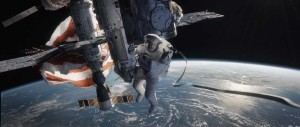 The 20 x 10-foot box, which the actors inhabited for much of the filming, wasn’t a perfectly calibrated machine from the outset.
The 20 x 10-foot box, which the actors inhabited for much of the filming, wasn’t a perfectly calibrated machine from the outset.
“The way light from the LED behaves is very strange,” Webber explained. “It’s not a smooth, natural light, which made it less than ideal. The spectrum coming out of it is also very spiky and gives off different colors in different directions; depending on where you are standing relative to the panel, you can see quite a different color. All that had to be accounted and allowed for, so the box definitely evolved over time.” Starting with a “very rough, basic version” of the new lighting concept during those initial tests proved rewarding. “Based on those early tests, we felt it could work,” he said. “We also learned more about the problems so we could work our ways around them. Only from that basic design could we come up with the more sophisticated, complicated final version.”
Much of that complexity came from needing a rugged, dependable system that was not fixed at all but inherently flexible.
“It had to be quite forgiving to be able to get different cameras inside but also to respond to the actors’ performances,” said Webber. “When you arrive on set, you still need to be able to tweak the lighting once the actor is there, or be able to change the timing of the performance literally as they are doing it in order to follow the performance in real time. Since everything was preplanned during pre-vis, we had to add all that flexibility into how the lighting was controlled on set.”
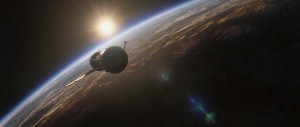 The Light Box was “the surprise success” of the shoot, he said. “We went into it intending to shoot the main ‘head-only’ shots in one of three ways: traditional lighting, Light Box lighting and moving lights around on robots. We ended up pushing a lot more into the Light Box, mainly out of the robots but even some out of traditional section. And you know, the LED lights lent a very complex lighting to the scenes that more traditional lighting just couldn’t.”
The Light Box was “the surprise success” of the shoot, he said. “We went into it intending to shoot the main ‘head-only’ shots in one of three ways: traditional lighting, Light Box lighting and moving lights around on robots. We ended up pushing a lot more into the Light Box, mainly out of the robots but even some out of traditional section. And you know, the LED lights lent a very complex lighting to the scenes that more traditional lighting just couldn’t.”
At one point the Light Box panels were even extracted from the box to light other sequences that would have never fit inside, like the 12-wire rig controlled by veteran puppeteers (from the original stage production of War Horse) that moved Bullock through weightless space.
“Everything needs puppeteering in space,” he said. “We originally brought them on for a few specific tasks but almost in the same way as with the Light Box, once they were there on set, we found all sorts of uses for them. They supported Sandra’s or George’s limbs and legs when they needed it but just as brilliantly drifted a book across the scene by grabbing it out of Sandra’s hands. They truly controlled Sandra as if she were a marionette.” Acting under these circumstances, guided by the puppeteers, was a challenge aided by the fact that “They were used to working with people in this way,” he said, “and had puppeteered people before. Sandra developed a wonderful, trusting working relationship with Avye Leventis, one of the puppeteers. Every move was based on what Sandra wanted to do, and it just became a natural, flowing thing. Avye really took charge of it the movement so Sandra could concentrate on the whole performance.”
Rendering Weightlessness, the Stars and Planet Earth

The majority of the film’s images were rendered natively in 3D or converted by Framestore effects artists, with Prime Focus stepping in to convert the predominantly live-action scenes shot in 2D with the ARRI Alexa digital camera.
“Every film is a step forward in terms of stereo conversion’s evolution, and Gravity is certainly a high point in conversion’s quality and creativity,” said Matthew Bristowe, SVP production, View-D and VFX of Prime Focus World.
“But it’s really about creating that illusion of stereo no matter how you do it,” added Richard Baker, Prime Focus’ stereographer visual effects supervisor. “Whether Tim and his team are rendering it in Maya or shooting it with two cameras or we’re converting it and creating a new eye, there’s no right or wrong way of doing it.”
Baker worked with Cuarón, Webber and stereo supervisor Chris Parks to plan the shots that would be converted, using a newer combination of rotoscoping, geometry and LIDAR, a 3D laser mapping technology that Microsoft Kinect, for example, uses to turn the invisible infrared light coming off our bodies into dynamic avatars on screen. “Using the geometry for the capture gave it a consistency in terms of depth across the whole shot. It was a really flexible technical approach to conversion that I don’t think has been done before.”
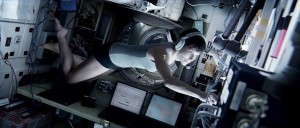 Webber agrees that an evolving mix of native and converted methods is the future of stereo filmmaking. “Movies shouldn’t have to be one thing or the other. There are times when it is better to shoot stereo and render stereo and there are times when conversion works well, given the limitations on set. Nothing wrong with taking a hybrid approach.”
Webber agrees that an evolving mix of native and converted methods is the future of stereo filmmaking. “Movies shouldn’t have to be one thing or the other. There are times when it is better to shoot stereo and render stereo and there are times when conversion works well, given the limitations on set. Nothing wrong with taking a hybrid approach.”
It could also banish the often inverted and unfair fix-it-in-post mentality for good.
“We now get involved much earlier on in the entire visual effects and creative process,” said Bristowe. “When people tend to think of a converted movie, they imagine it completed and it’s a bolt onto the end to bring some extra buck to the box office. Even those kinds of films are becoming few and far between, thank goodness.”
The early collaboration also meant artistry was part of design of stereo shots from the outset.
“For Chris Parks, it’s not just about how much depth you get in a shot but it’s also about the layers of separation,” said Baker. “Chris worked with the team during pre-vis to really plan those stereo shots. It was great for me, with a background in VFX and conversion, to work with a native stereographer who’s got a differently trained eye.”

Bringing the Framestore artists up to speed on the nuances of rendered weightlessness was no easy task, as the physics of outer space are unlike most traditional environments an animator is taught to understand.
“We made an enormous effort to stick to reality wherever possible,” Webber said. “NASA supplied a huge amount of stills and footage and we spent a long time with those images and watching their YouTube channel. But we also had to break a lot of habits that these artists have had for years. For a place you can’t possibly go to you couldn’t ask for more reference, really.”
Webber also went up in a parabolic airplane flight, the proverbial “vomit comet” used to film the weightless sequences of Apollo 13. “That was useful research for me but not everyone could go up in that. If you suffer from travel sickness, which I’m lucky enough not to, then it is just horrible. I really loved it. But I went up with a stunt woman who was sick very early on and because you obviously can’t get off, the poor thing had to continue through the ups and downs suffering.”
“We discussed the theory of weightlessness and no-air resistance and all of those sort of things with the animators. Looking at the reference doesn’t necessarily enlighten you to what’s going on if you don’t really understand the theory of why it’s going on,” said Webber. He studied physics at Oxford and taught it before launching his VFX career. “We did have these little physics lectures going on here at Framestore. But neither does understanding the theory alone allow you as an animator to put it into practice. That took experimentation and practice, breaking of those habits.”
Those lessons extended to the upper echelons of the team, though the art of filmmaking still won out over the realities of science in some cases.
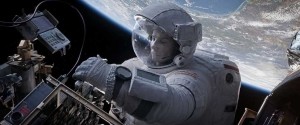 “We did have to gloss over certain physical realities in space to make the narrative hold together. A few of us, for example, had a lengthy discussion about the complexities of orbital dynamics, which we decided was just so weird and difficult that we would not address it in the film in any way,” said Webber. “It would just make everything seem wrong. If you want to catch up with something in space, you have to fire your engines in directly the opposite direction so you drop into a different, faster orbit, which allows you to catch up with the higher orbit eventually. But if we showed that on screen, the audience wouldn’t understand what was going on.”
“We did have to gloss over certain physical realities in space to make the narrative hold together. A few of us, for example, had a lengthy discussion about the complexities of orbital dynamics, which we decided was just so weird and difficult that we would not address it in the film in any way,” said Webber. “It would just make everything seem wrong. If you want to catch up with something in space, you have to fire your engines in directly the opposite direction so you drop into a different, faster orbit, which allows you to catch up with the higher orbit eventually. But if we showed that on screen, the audience wouldn’t understand what was going on.”
The gorgeous, detailed renderings of a slowly shifting earth give heft to the film’s primary drama in space.
“The earth is the constant background for 60 percent of the movie,” admitted Webber, “so we had to get a lot out of the earth—and get it right. With the single location in space, we knew we had to get a lot of variety out of it to keep the audience interested. Within that goal was using it to reflect the various moods present at the different stages of the story. We had to try and make that work within the general orbital terms we understand, so we used what bit or land or water we were over, whether it was day or night, and lighting effects. All those factors took a lot of very careful planning and working out.”
The stars presented a more subtle challenge.
“To be honest, there is not a whole lot you can get out of stars. The way the stars look changes quite a lot, depending on whether or not the sun is out from where you are in space,” said Webber. “In reality, you can’t see any stars during the day time, like here on earth, so we cheated and left the minimal amount of stars when the sun was up because without that it’s too confusing for the audience. There’s no point of reference, so you can’t see camera moves, so we just left as few stars as we felt we could possibly get away with. Then at night, there are more stars, and in one scene, even the moon is absent, so that’s where we could really plumb the depths of starry space.” The animators began with 20,000 stars and arranged them in the correct pattern in the night sky, said Webber, “but it felt like there wasn’t nearly enough. We actually added a few million smaller, extra stars filling in the gaps so it felt like it had that depth.”
Another example of form over function was the film’s depiction of the shuttle undocking procedure.
“It takes a very long time. Our astronaut on set said, ‘You can’t do that in two minutes; that takes at least 20!’ But try doing that for 20 minutes in a movie. The same thing with Sandra getting her spacesuit off. In reality, it’s a three-person job to get out of a spacesuit and takes half an hour, so we had to opt for a much quicker, simpler method,” said Webber.
Although the artists relied on Autodesk Maya for the gargantuan task of modeling and animation entire scenes and props and on Adobe Photoshop and The Foundry‘s MARI to add in the layers of texture and aged patina that surround Bullock in her weightless confinement inside the space station, Webber said artistry plays as much a role in these executions as tools.
“It’s really more about the eye of the people working it up to the right level of detail and the time spent looking at the reference that inspired those details. It comes down to craft, to have the eye to know when it’s working and when it’s not,” said Webber.
Webber admitted the entire experience, despite being longer than usual, was like no other he’s had to date, including previous work with Cuarón.
“It was an exceptionally collaborative effort working alongside Alfonso and it was so rewarding to be such an integral part of the whole filmmaking process.”
It is worth pointing out that though “3D” appears in the original script’s title, you won’t find it explicitly stated anywhere in the final film or its marketing. Will that nudge audiences toward a fuller understanding that a movie should be defined by the sum of its filmmaking and not by its format?
“This isn’t just another 3D movie or another space film,” said Matt Bristowe. “It’s really one of those tent pole movies of your career that only come along once, if you’re lucky. To be a part of it is very special.”





